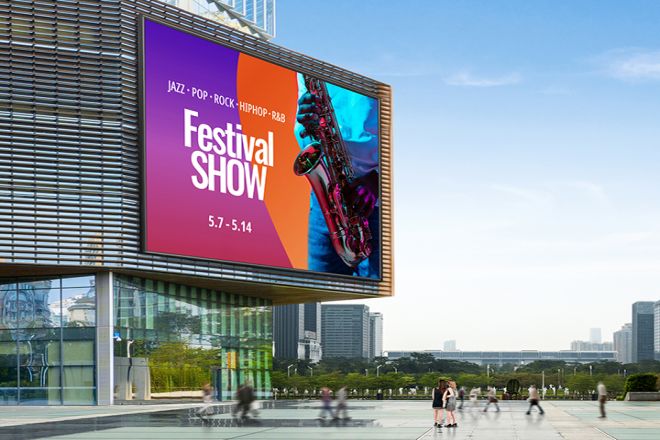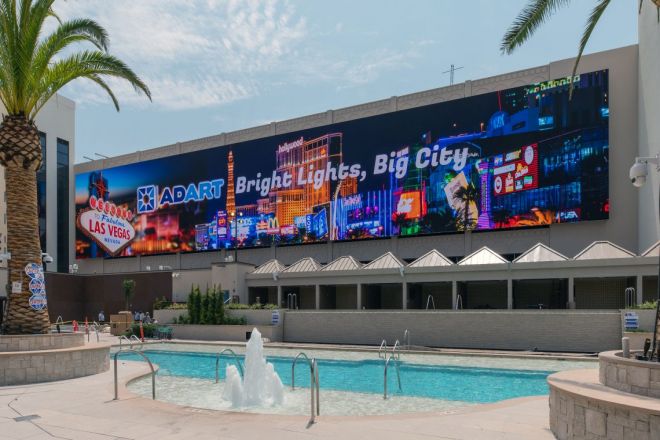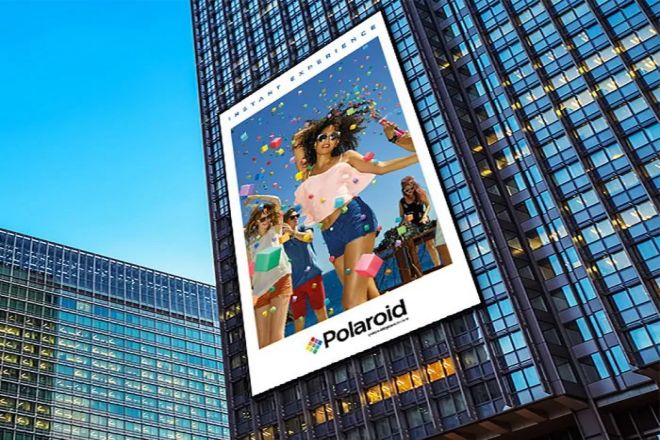Introduction

As an intuitive reflection of the city’s image, urban architecture’s design concepts and architectural styles not only reflect the city’s cultural heritage and historical heritage but also demonstrate the city’s modernization and future development potential.
In this context, the combination of outdoor LED displays and urban architecture not only brings a new visual experience to urban architecture but also injects new vitality into the spread of urban culture and economic development.
1. The functional role of outdoor LED displays in urban buildings
- Advertising and information transfer
Outdoor LED displays play an important role in advertising and information transmission in urban buildings. They have significant advantages, allowing advertisements and information to be disseminated quickly and widely to the public.
- Advantages of LED display as advertising media
As a modern advertising medium, LED display screens have obvious advantages.
First of all, the LED display screen has the characteristics of high brightness and high definition, which can ensure that the advertising content is clearly visible even in the daytime when the light is strong. Secondly, the LED display supports dynamic display and can display multimedia content such as animations and videos, making advertisements more attractive and visually impactful.
In addition, the LED display screen can also be remotely controlled through the network to achieve real-time updates and changes in advertising to meet the needs of different customers.
- Update information in real-time to improve publicity effectiveness.
Another important function of outdoor LED displays is the real-time updating of information. Whether it is commercial advertising, public welfare activities, or emergency notifications, LED displays can quickly and accurately display relevant information. This real-time nature not only improves the efficiency of information dissemination but also enhances the effectiveness of advertising.
Through LED displays, merchants can flexibly adjust advertising strategies, timely release new product information, promotional activities, etc., to attract consumers’ attention.
- Beautify urban landscape
In addition to the functions of advertising and information transmission, outdoor LED displays can also beautify the urban landscape and enhance the visual appeal of urban buildings.
- Integration design of LED display screen and architectural appearance
With the update of design concepts and advancement of technology, the integration design of LED display screens and architectural appearance has attracted more and more attention.
Through clever ideas and careful layout, designers integrate LED displays into the building’s appearance, making it a part of the building. This integrated design not only makes the building more beautiful and elegant but also improves the visual effect and ornamental value of the LED display.
- Improve the visual appeal of urban buildings.
The addition of LED displays adds new visual elements to urban architecture. At night, when the LED display lights up, the building seems to be lit up, emitting a charming light. This unique visual effect not only attracts people’s attention but also enhances the visual appeal of urban architecture.
At the same time, LED displays can also be changed and adjusted according to different occasions, such as festivals and events, bringing a rich and colorful visual experience to the city.
- Night lighting and security
In addition to the above functions, outdoor LED displays also have certain night lighting functions, which can improve the safety and visibility of buildings at night.
- LED display lighting function
The LED display itself has a certain brightness and can be used as a lighting facility for buildings. At night, when the lights around the building go out, the lighting function of the LED display can provide the necessary lighting for the building so that the building is still clearly visible in the dark.
- Improve building safety and visibility at night.
The lighting function of LED displays not only beautifies the city night scene but also improves the safety and visibility of buildings at night. In situations where the light is dark, or visibility is low, the lighting of LED displays can provide necessary guidance and warning for pedestrians and vehicles, reducing the occurrence of traffic accidents and safety hazards.
2. Integration design of outdoor LED display and urban architecture

- Design concepts and principles
In the integration design of outdoor LED displays and urban buildings, certain design concepts and principles must be followed to ensure harmony and unity between the two.
- Emphasis on coordination and unity with architectural style
Integrated design first requires that the appearance design, material, color, and other aspects of the LED display should be coordinated with the architectural style.
For example, for a modern minimalist style building, the LED display can use simple lines and colors to highlight the simple beauty of the building, while for a classical style building, the LED display can be designed with traditional patterns and colors to match the design. The architectural styles are coordinated.
- Consider the overall effect of the urban environment.
In addition to harmonizing with the architectural style, integrated design also needs to consider the overall effect of the urban environment. The installation location, size, brightness, etc., of the LED display needs to be adjusted according to the surrounding environment to ensure that it will not have a negative impact on the urban environment.
For example, in bustling commercial areas, the brightness of LED displays can be appropriately increased to attract more people’s attention, while in residential areas, the brightness needs to be reduced to reduce the impact on residents’ lives.
1). Case analysis
- Introduction to cases of successful integration of LED display screens and buildings at home and abroad.
There are many successful cases at home and abroad that demonstrate the perfect integration of LED displays and buildings. For example, the LED transparent screen in the Shanghai Jinhongqiao International Center sightseeing elevator project not only meets the needs of tourists for panoramic sightseeing but also fully demonstrates the technological features of modern architecture.
In the Xi’an Sihai Chinatown project, the LED transparent screen is perfectly integrated with the building to form a unique landscape effect. These cases all demonstrate the infinite possibilities of integrated design of LED displays and buildings.
- Analyze its design features and effects.
The design features of these successful cases mainly include: first, coordination with the architectural style. Whether it is modern simplicity or classical style, the LED display can be perfectly integrated with the building; second, considering the overall effect of the urban environment, ensuring that the LED display does not It will have a negative impact on the urban environment.
Third, use advanced technology and materials to ensure the display effect and durability of the LED display. These design features make the integration between LED displays and buildings more natural and harmonious, bringing a better visual experience to the city.
2). Design trends and prospects
- Predict future design trends for the integration of LED displays and buildings.
With the advancement of science and technology and innovation in design, the future design of LED display screens and buildings will show the following trends:
First, more emphasis will be placed on personalized design and customized designs based on the characteristics and needs of the building; second, more emphasis will be placed on environmental protection and To save energy, use more environmentally friendly materials and technologies to reduce energy consumption
Third, pay more attention to interactivity and intelligence, and achieve interaction with users and intelligent control through technologies such as the Internet of Things and big data.
- Explore possible innovations and challenges.
In terms of innovation, future designs may further integrate LED displays with other parts of the building, such as using them with building skins, windows, etc., to create a unique visual effect. At the same time, with the continuous emergence of new materials and new technologies, the performance of LED displays will be further improved.
However, some challenges are also faced in the process of integrating design. The first is how to ensure the display effect of the LED display while reducing its impact on the appearance of the building and the surrounding environment; the second is how to fully consider energy saving and environmental protection factors in the design
And the last is how to ensure the safety between the LED display and the building. connection and stable operation. These challenges require designers and engineers to work together to overcome them.
3. The impact of outdoor LED displays on urban architecture
1). Economic benefits
The primary impact of outdoor LED displays on urban architecture is reflected in economic benefits.
- The commercial value brought by LED display screens to urban buildings:
As an efficient advertising medium, LED display screens can attract a large number of people and vehicles and increase the commercial value of urban buildings.
Merchants display product advertisements, promotional activities, and other information through LED displays, which can effectively attract potential consumers and increase sales opportunities. In addition, LED displays can also create additional rental income for urban buildings and increase the economic value of the building.
- Promote urban economic development:
The wide application of LED displays not only drives the development of the advertising industry but also promotes the growth of related industrial chains such as electronics, materials, manufacturing, and other industries.
At the same time, the commercial value and economic benefits that LED displays bring to the city also indirectly promote the prosperity of the city’s overall economy.
2). Social benefits
The social benefits of outdoor LED displays to urban buildings are also significant.
- Improve the image and popularity of the city:
LED display screens can improve the appearance and taste of urban buildings and enhance the image of the city by displaying exquisite advertising content, city promotional videos, and other information.
At the same time, as a business card of the city, the LED display screen can attract more tourists and investors and increase the city’s visibility and influence.
- Enhance community interaction and cultural dissemination:
LED display screens can be used as a platform for community information release and event promotion to promote interaction and communication among community residents. By displaying community culture, history, art, and other content, LED displays can also inherit and promote urban culture and enhance residents’ sense of cultural identity and belonging.
3). Environmental benefits
3.1). Outdoor LED displays also play an active role in environmental protection.
- Energy-saving and environmentally friendly features of LED displays:
LED displays use efficient and energy-saving LED light sources, which have lower energy consumption than traditional lighting systems.
At the same time, the LED display screen generates less heat, reducing thermal pollution to the environment. In addition, the long service life of LED displays reduces the frequency of replacement and repair and reduces waste generation.
- Positive impact on the urban environment:
The widespread application of LED displays helps reduce the use of paper posters and leaflets, reducing resource consumption and waste emissions. At the same time, LED displays can also improve the public’s environmental awareness and promote the improvement and sustainable development of the urban environment by displaying public service advertisements such as environmental protection and energy saving.
4. Challenges and countermeasures of outdoor LED display screens in urban building applications technical challenges

1). The main technical challenges faced by outdoor LED displays include the balance and optimization of technical indicators such as brightness, color, and resolution.
1.1). Challenge analysis
Brightness: Outdoor LED displays need to be bright enough to remain clearly visible in daylight, but too high a brightness may cause light pollution problems at night.
Color and resolution: In order to provide a high-quality visual experience, the display needs to have excellent color reproduction capabilities and high resolution. However, this also increases manufacturing costs and energy consumption.
1.2). Solutions and technological advancements:
Research and develop intelligent brightness adjustment technology: automatically adjust the brightness of the display screen according to changes in ambient light, ensuring clarity during the day and reducing light pollution at night.
Optimize display technology: Improve the luminous efficiency and color accuracy of LED chips while reducing energy consumption.
Introducing high-resolution display technology: By increasing the pixel density of the LED display, higher-quality image display is achieved.
2). Regulations and Policies
The government’s regulation and management of outdoor LED displays is another important challenge.
2.1). Challenge analysis:
The government has strict regulatory requirements on the settings, content, brightness, etc., of outdoor LED displays.
Unapproved outdoor LED displays may face fines, demolition, and other penalties.
2.2). Countermeasures and Suggestions:
Comply with relevant regulations: Before setting up an outdoor LED display, be sure to understand and comply with local regulations and policies.
Reasonable layout: According to urban planning and municipal facilities layout, outdoor LED displays should be set up scientifically and rationally to avoid negative impacts on the environment and city image.
3). Visual pollution and light pollution
Excessive use and improper installation of outdoor LED displays may lead to visual pollution and light pollution problems.
3.1). Challenge analysis:
Overly dense LED displays may bring a sense of clutter to urban landscapes.
High-brightness display screens may cause light pollution at night, affecting residents’ lives and the ecological environment.
3.2). Countermeasures and Suggestions:
Limit the quantity and density: Through planning and management methods, limit the quantity and density of outdoor LED displays to avoid overuse.
Introducing brightness adjustment technology: As mentioned earlier, light pollution is reduced through intelligent brightness adjustment technology.
Strengthen supervision and law enforcement: The government should strengthen supervision and law enforcement of outdoor LED displays to ensure compliance.
Enhance public awareness: Through publicity and education activities, public awareness of visual pollution and light pollution issues will be increased, and the urban environment and residents’ quality of life will be jointly maintained.
Conclusion
To sum up, there is an inseparable relationship between outdoor LED displays and urban architecture. It not only adds a bright appearance and changeable character to urban architecture, but also becomes an important medium for advertising and information transmission. At the same time, the application of outdoor LED displays has also been supported by government policies, bringing social and economic benefits to the city.
If you want to know more information about LED displays, please get in touch with us.
